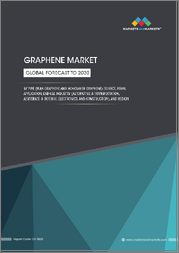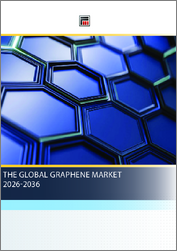
|
시장보고서
상품코드
1796967
2D 재료 시장 : 세계 산업 규모, 점유율, 동향, 기회, 예측 : 유형별, 용도별, 지역별, 경쟁별(2020-2030년)2D Materials Market - Global Industry Size, Share, Trends, Opportunity, and Forecast, Segmented By Type, By Application, By Region and Competition, 2020-2030F |
||||||
세계의 2D 재료 시장 규모는 2024년에 11억 6,000만 달러에 달하며, 2030년에는 CAGR은 3.75%로, 14억 3,000만 달러에 달할 것으로 예측됩니다.
원자 단위의 두께와 뛰어난 전기적, 기계적, 열적 특성을 특징으로 하는 2D 소재는 다양한 기술에 혁명을 가져올 수 있는 가능성으로 큰 주목을 받고 있습니다. 현재 가장 주목받는 2D 소재인 그래핀은 뛰어난 전도성, 강도, 유연성으로 인해 시장을 독점하고 있습니다. 그러나 시장에서는 육방정계 질화붕소(h-BN), 전이금속 다이칼코게나이드(TMD), MXen과 같은 다른 재료에 대한 관심도 높아지고 있습니다.
| 시장 개요 | |
|---|---|
| 예측 기간 | 2026-2030년 |
| 시장 규모 : 2024년 | 11억 6,000만 달러 |
| 시장 규모 : 2030년 | 14억 3,000만 달러 |
| CAGR : 2025-2030년 | 3.75% |
| 급성장 부문 | 그래핀 |
| 최대 시장 | 북미 |
이러한 대체 재료는 플렉서블 전자, 에너지 저장, 코팅, 차세대 반도체 등 특정 용도를 위해 검토되고 있습니다. 시장 전망은 밝지만 몇 가지 과제도 남아있습니다. 생산의 확장성, 높은 제조 비용, 표준화된 통합 기술의 필요성 등이 대량 채택의 장벽으로 작용하고 있습니다. 또한 나노물질의 취급과 관련된 규제적 고려사항과 환경에 미치는 영향에 대해서도 신중하게 대처해야 합니다.
주요 시장 성장 촉진요인
제약 산업의 성장
주요 시장 이슈
높은 생산 비용
주요 시장 동향
첨단 전자 용도의 대중화
목차
제1장 개요
제2장 조사 방법
제3장 개요
제4장 COVID-19가 세계의 2D 재료 시장에 미치는 영향
제5장 세계의 2D 재료 시장 전망
- 시장 규모·예측
- 금액별
- 시장 점유율·예측
- 유형별(그래핀, 흑린, 실리콘, 전이금속 다이카르코게나이드, 육방정질화 붕소, 기타)
- 용도별(의약품, 에너지 저장 디바이스·반도체, 자동차·항공기, 기타)
- 지역별
- 기업별(2024년)
- 시장 맵
제6장 북미의 2D 재료 시장 전망
- 시장 규모·예측
- 시장 점유율·예측
- 북미 : 국가별 분석
- 미국
- 멕시코
- 캐나다
제7장 유럽의 2D 재료 시장 전망
- 시장 규모·예측
- 시장 점유율·예측
- 유럽 : 국가별 분석
- 프랑스
- 독일
- 영국
- 이탈리아
- 스페인
제8장 아시아태평양의 2D 재료 시장 전망
- 시장 규모·예측
- 시장 점유율·예측
- 아시아태평양 : 국가별 분석
- 중국
- 인도
- 한국
- 일본
- 호주
제9장 남미의 2D 재료 시장 전망
- 시장 규모·예측
- 시장 점유율·예측
- 남미 : 국가별 분석
- 브라질
- 아르헨티나
- 콜롬비아
제10장 중동 및 아프리카의 2D 재료 시장 전망
- 시장 규모·예측
- 시장 점유율·예측
- 중동 및 아프리카 : 국가별 분석
- 남아프리카공화국
- 사우디아라비아
- 아랍에미리트
제11장 시장 역학
- 촉진요인
- 과제
제12장 시장 동향과 발전
- 합병과 인수
- 제품 출시
- 최근 동향
제13장 혼란 : 분쟁, 팬데믹, 무역장벽
제14장 세계의 2D 재료 시장 : SWOT 분석
제15장 Porter의 산업 분석
- 업계내 경쟁
- 신규 참여의 가능성
- 공급업체의 힘
- 고객의 힘
- 대체품의 위협
제16장 경쟁 구도
- BASF SE
- NanoXplore Inc.
- Cabot Corporation
- Thomas Swan & Co. Ltd.
- Ossila Ltd
- 2D Materials Pte Ltd
- Nitronix Nanotechnology Corporation
- Smart-elements GmbH
- ACS Material LLC
- Layer One-Advanced Materials
제17장 전략적 제안
제18장 조사회사 소개·면책사항
KSA 25.09.02Global 2D Materials Market was valued at USD 1.16 Billion in 2024 and is expected to reach USD 1.43 Billion by 2030 with a CAGR of 3.75%. Two-dimensional materials characterized by their atomic-scale thickness and exceptional electrical, mechanical, and thermal properties are gaining significant attention for their potential to revolutionize a wide array of technologies. Graphene, currently the most prominent 2D material, continues to dominate the market due to its remarkable conductivity, strength, and flexibility. However, the market is also witnessing growing interest in other materials such as hexagonal boron nitride (h-BN), transition metal dichalcogenides (TMDs), and MXenes.
| Market Overview | |
|---|---|
| Forecast Period | 2026-2030 |
| Market Size 2024 | USD 1.16 Billion |
| Market Size 2030 | USD 1.43 Billion |
| CAGR 2025-2030 | 3.75% |
| Fastest Growing Segment | Graphene |
| Largest Market | North America |
These alternatives are being explored for specific applications such as flexible electronics, energy storage, coatings, and next-generation semiconductors. Despite the market's promising outlook, several challenges persist. Scalability of production, high manufacturing costs, and the need for standardized integration techniques remain barriers to mass adoption. Moreover, regulatory considerations and environmental impacts associated with nanomaterial handling must be carefully addressed.
Key Market Drivers
Growth in Pharmaceutical Industry
The rapid expansion of the pharmaceutical industry is emerging as a significant driver of growth within the global 2D materials market. The global pharmaceutical industry has witnessed substantial expansion over the past two decades, reaching approximately USD 1.6 trillion in revenue by 2023. This level of growth positions the industry's market size on par with the gross domestic products (GDPs) of major economies such as Spain, Mexico, or Australia. As the sector increasingly embraces advanced materials to enhance drug delivery, diagnostics, and biomedical research, the unique physicochemical properties of 2D materials such as graphene, molybdenum disulfide (MoS2), and boron nitride are being leveraged to meet evolving performance standards and innovation demands.
2D materials are particularly valued for their ultra-thin structure, high surface area, biocompatibility, and tunable electronic and optical properties. These attributes have opened new avenues in targeted drug delivery systems, where 2D nanocarriers enable precision-controlled release and improved bioavailability. Notably, Alfa Chemistry offers and customizes a diverse range of 2D materials tailored for antimicrobial and antifouling surface applications. In addition to graphene materials (GMs), molybdenum disulfide (MoS2), and hexagonal boron nitride (h-BN), several other 2D materials have also been utilized for such purposes particularly those that facilitate drug delivery and combine photothermal therapy (PTT) with photodynamic therapy (PDT), leveraging their strong near-infrared light absorption capabilities. In addition, their application in biosensors has enhanced the sensitivity and accuracy of diagnostics, aligning with the pharmaceutical industry's increasing focus on early disease detection and personalized medicine.
Key Market Challenges
High Cost of Production
One of the most pressing challenges facing the global 2D materials market is the high cost of production, which significantly hampers large-scale commercialization and industrial adoption. Although materials like graphene and other two-dimensional compounds offer remarkable mechanical, electrical, and thermal properties, the processes required to produce them with high purity, uniformity, and scalability remain complex and expensive.
Current manufacturing methods, such as chemical vapor deposition (CVD), mechanical exfoliation, and liquid-phase exfoliation, often involve high energy consumption, expensive raw materials, and time-intensive procedures. Moreover, achieving consistent material quality and layer thickness across large surface areas adds further technical and financial burden. These constraints not only elevate production costs but also limit the ability to meet growing industrial demand, particularly for applications requiring large volumes such as batteries, coatings, or flexible electronics.
Key Market Trends
Proliferation of Advanced Electronic Applications
The proliferation of advanced electronic applications is shaping a transformative trend in the global 2D materials market. As the demand for faster, smaller, and more energy-efficient devices intensifies, 2D materials are increasingly being adopted across a broad spectrum of next-generation electronic technologies. Their exceptional electrical conductivity, mechanical flexibility, and atomic-level thickness make them ideal candidates for applications where conventional materials fall short.
One of the most notable areas of impact is the development of flexible and wearable electronics. 2D materials such as graphene and transition metal dichalcogenides (TMDs) enable the fabrication of ultra-thin, bendable circuits and sensors, opening new possibilities in smart textiles, biomedical wearables, and flexible displays. Researchers have also showcased the development of printable applications and devices based on 2D materials using digital inkjet printing techniques. Although limited academic studies have focused on printed pressure and touch sensors utilizing 2D materials, several commercial entities have incorporated comparable devices in various demonstration projects. These materials provide the mechanical strength and electrical performance needed for continuous and reliable operation in dynamic environments.
Key Market Players
- BASF SE
- NanoXplore Inc.
- Cabot Corporation
- Thomas Swan & Co. Ltd.
- Ossila Ltd
- 2D Materials Pte Ltd
- Nitronix Nanotechnology Corporation
- Smart-elements GmbH
- ACS Material LLC
- Layer One - Advanced Materials
Report Scope
In this report, the Global 2D Materials Market has been segmented into the following categories, in addition to the industry trends which have also been detailed below:
2D Materials Market, By Type:
- Graphene
- Black Phosphorous
- Silicone
- Transition Metal Dichalcogenides
- Hexagonal Boron Nitride
- Others
2D Materials Market, By Application:
- Pharmaceuticals
- Energy Storage Devices & Semiconductors
- Automobiles & Airplanes
- Others
2D Materials Market, By Region:
- North America
- United States
- Canada
- Mexico
- Europe
- France
- United Kingdom
- Italy
- Germany
- Spain
- Asia Pacific
- China
- India
- Japan
- Australia
- South Korea
- South America
- Brazil
- Argentina
- Colombia
- Middle East & Africa
- South Africa
- Saudi Arabia
- UAE
Competitive Landscape
Company Profiles: Detailed analysis of the major companies present in the Global 2D Materials Market.
Available Customizations:
Global 2D Materials Market report with the given market data, TechSci Research offers customizations according to a company's specific needs. The following customization options are available for the report:
Company Information
- Detailed analysis and profiling of additional market players (up to five).
Table of Contents
1. Product Overview
- 1.1. Market Definition
- 1.2. Scope of the Market
- 1.2.1. Markets Covered
- 1.2.2. Years Considered for Study
- 1.2.3. Key Market Segmentations
2. Research Methodology
- 2.1. Objective of the Study
- 2.2. Baseline Methodology
- 2.3. Key Industry Partners
- 2.4. Major Association and Secondary Sources
- 2.5. Forecasting Methodology
- 2.6. Data Triangulation & Validation
- 2.7. Assumptions and Limitations
3. Executive Summary
- 3.1. Overview of the Market
- 3.2. Overview of Key Market Segmentations
- 3.3. Overview of Key Market Players
- 3.4. Overview of Key Regions/Countries
- 3.5. Overview of Market Drivers, Challenges, and Trends
4. Impact of COVID-19 on Global 2D Materials Market
5. Global 2D Materials Market Outlook
- 5.1. Market Size & Forecast
- 5.1.1. By Value
- 5.2. Market Share & Forecast
- 5.2.1. By Type (Graphene, Black Phosphorous, Silicone, Transition Metal Dichalcogenides, Hexagonal Boron Nitride, Others)
- 5.2.2. By Application (Pharmaceuticals, Energy Storage Devices & Semiconductors, Automobiles & Airplanes, Others)
- 5.2.3. By Region
- 5.2.4. By Company (2024)
- 5.3. Market Map
6. North America 2D Materials Market Outlook
- 6.1. Market Size & Forecast
- 6.1.1. By Value
- 6.2. Market Share & Forecast
- 6.2.1. By Type
- 6.2.2. By Application
- 6.2.3. By Country
- 6.3. North America: Country Analysis
- 6.3.1. United States 2D Materials Market Outlook
- 6.3.1.1. Market Size & Forecast
- 6.3.1.1.1. By Value
- 6.3.1.2. Market Share & Forecast
- 6.3.1.2.1. By Type
- 6.3.1.2.2. By Application
- 6.3.1.1. Market Size & Forecast
- 6.3.2. Mexico 2D Materials Market Outlook
- 6.3.2.1. Market Size & Forecast
- 6.3.2.1.1. By Value
- 6.3.2.2. Market Share & Forecast
- 6.3.2.2.1. By Type
- 6.3.2.2.2. By Application
- 6.3.2.1. Market Size & Forecast
- 6.3.3. Canada 2D Materials Market Outlook
- 6.3.3.1. Market Size & Forecast
- 6.3.3.1.1. By Value
- 6.3.3.2. Market Share & Forecast
- 6.3.3.2.1. By Type
- 6.3.3.2.2. By Application
- 6.3.3.1. Market Size & Forecast
- 6.3.1. United States 2D Materials Market Outlook
7. Europe 2D Materials Market Outlook
- 7.1. Market Size & Forecast
- 7.1.1. By Value
- 7.2. Market Share & Forecast
- 7.2.1. By Type
- 7.2.2. By Application
- 7.2.3. By Country
- 7.3. Europe: Country Analysis
- 7.3.1. France 2D Materials Market Outlook
- 7.3.1.1. Market Size & Forecast
- 7.3.1.1.1. By Value
- 7.3.1.2. Market Share & Forecast
- 7.3.1.2.1. By Type
- 7.3.1.2.2. By Application
- 7.3.1.1. Market Size & Forecast
- 7.3.2. Germany 2D Materials Market Outlook
- 7.3.2.1. Market Size & Forecast
- 7.3.2.1.1. By Value
- 7.3.2.2. Market Share & Forecast
- 7.3.2.2.1. By Type
- 7.3.2.2.2. By Application
- 7.3.2.1. Market Size & Forecast
- 7.3.3. United Kingdom 2D Materials Market Outlook
- 7.3.3.1. Market Size & Forecast
- 7.3.3.1.1. By Value
- 7.3.3.2. Market Share & Forecast
- 7.3.3.2.1. By Type
- 7.3.3.2.2. By Application
- 7.3.3.1. Market Size & Forecast
- 7.3.4. Italy 2D Materials Market Outlook
- 7.3.4.1. Market Size & Forecast
- 7.3.4.1.1. By Value
- 7.3.4.2. Market Share & Forecast
- 7.3.4.2.1. By Type
- 7.3.4.2.2. By Application
- 7.3.4.1. Market Size & Forecast
- 7.3.5. Spain 2D Materials Market Outlook
- 7.3.5.1. Market Size & Forecast
- 7.3.5.1.1. By Value
- 7.3.5.2. Market Share & Forecast
- 7.3.5.2.1. By Type
- 7.3.5.2.2. By Application
- 7.3.5.1. Market Size & Forecast
- 7.3.1. France 2D Materials Market Outlook
8. Asia Pacific 2D Materials Market Outlook
- 8.1. Market Size & Forecast
- 8.1.1. By Value
- 8.2. Market Share & Forecast
- 8.2.1. By Type
- 8.2.2. By Application
- 8.2.3. By Country
- 8.3. Asia Pacific: Country Analysis
- 8.3.1. China 2D Materials Market Outlook
- 8.3.1.1. Market Size & Forecast
- 8.3.1.1.1. By Value
- 8.3.1.2. Market Share & Forecast
- 8.3.1.2.1. By Type
- 8.3.1.2.2. By Application
- 8.3.1.1. Market Size & Forecast
- 8.3.2. India 2D Materials Market Outlook
- 8.3.2.1. Market Size & Forecast
- 8.3.2.1.1. By Value
- 8.3.2.2. Market Share & Forecast
- 8.3.2.2.1. By Type
- 8.3.2.2.2. By Application
- 8.3.2.1. Market Size & Forecast
- 8.3.3. South Korea 2D Materials Market Outlook
- 8.3.3.1. Market Size & Forecast
- 8.3.3.1.1. By Value
- 8.3.3.2. Market Share & Forecast
- 8.3.3.2.1. By Type
- 8.3.3.2.2. By Application
- 8.3.3.1. Market Size & Forecast
- 8.3.4. Japan 2D Materials Market Outlook
- 8.3.4.1. Market Size & Forecast
- 8.3.4.1.1. By Value
- 8.3.4.2. Market Share & Forecast
- 8.3.4.2.1. By Type
- 8.3.4.2.2. By Application
- 8.3.4.1. Market Size & Forecast
- 8.3.5. Australia 2D Materials Market Outlook
- 8.3.5.1. Market Size & Forecast
- 8.3.5.1.1. By Value
- 8.3.5.2. Market Share & Forecast
- 8.3.5.2.1. By Type
- 8.3.5.2.2. By Application
- 8.3.5.1. Market Size & Forecast
- 8.3.1. China 2D Materials Market Outlook
9. South America 2D Materials Market Outlook
- 9.1. Market Size & Forecast
- 9.1.1. By Value
- 9.2. Market Share & Forecast
- 9.2.1. By Type
- 9.2.2. By Application
- 9.2.3. By Country
- 9.3. South America: Country Analysis
- 9.3.1. Brazil 2D Materials Market Outlook
- 9.3.1.1. Market Size & Forecast
- 9.3.1.1.1. By Value
- 9.3.1.2. Market Share & Forecast
- 9.3.1.2.1. By Type
- 9.3.1.2.2. By Application
- 9.3.1.1. Market Size & Forecast
- 9.3.2. Argentina 2D Materials Market Outlook
- 9.3.2.1. Market Size & Forecast
- 9.3.2.1.1. By Value
- 9.3.2.2. Market Share & Forecast
- 9.3.2.2.1. By Type
- 9.3.2.2.2. By Application
- 9.3.2.1. Market Size & Forecast
- 9.3.3. Colombia 2D Materials Market Outlook
- 9.3.3.1. Market Size & Forecast
- 9.3.3.1.1. By Value
- 9.3.3.2. Market Share & Forecast
- 9.3.3.2.1. By Type
- 9.3.3.2.2. By Application
- 9.3.3.1. Market Size & Forecast
- 9.3.1. Brazil 2D Materials Market Outlook
10. Middle East and Africa 2D Materials Market Outlook
- 10.1. Market Size & Forecast
- 10.1.1. By Value
- 10.2. Market Share & Forecast
- 10.2.1. By Type
- 10.2.2. By Application
- 10.2.3. By Country
- 10.3. MEA: Country Analysis
- 10.3.1. South Africa 2D Materials Market Outlook
- 10.3.1.1. Market Size & Forecast
- 10.3.1.1.1. By Value
- 10.3.1.2. Market Share & Forecast
- 10.3.1.2.1. By Type
- 10.3.1.2.2. By Application
- 10.3.1.1. Market Size & Forecast
- 10.3.2. Saudi Arabia 2D Materials Market Outlook
- 10.3.2.1. Market Size & Forecast
- 10.3.2.1.1. By Value
- 10.3.2.2. Market Share & Forecast
- 10.3.2.2.1. By Type
- 10.3.2.2.2. By Application
- 10.3.2.1. Market Size & Forecast
- 10.3.3. UAE 2D Materials Market Outlook
- 10.3.3.1. Market Size & Forecast
- 10.3.3.1.1. By Value
- 10.3.3.2. Market Share & Forecast
- 10.3.3.2.1. By Type
- 10.3.3.2.2. By Application
- 10.3.3.1. Market Size & Forecast
- 10.3.1. South Africa 2D Materials Market Outlook
11. Market Dynamics
- 11.1. Drivers
- 11.2. Challenges
12. Market Trends & Developments
- 12.1. Merger & Acquisition (If Any)
- 12.2. Product Launches (If Any)
- 12.3. Recent Developments
13. Disruptions : Conflicts, Pandemics and Trade Barriers
14. Global 2D Materials Market: SWOT Analysis
15. Porters Five Forces Analysis
- 15.1. Competition in the Industry
- 15.2. Potential of New Entrants
- 15.3. Power of Suppliers
- 15.4. Power of Customers
- 15.5. Threat of Substitute Products
16. Competitive Landscape
- 16.1. BASF SE
- 16.1.1. Business Overview
- 16.1.2. Company Snapshot
- 16.1.3. Products & Services
- 16.1.4. Financials (As Reported)
- 16.1.5. Recent Developments
- 16.1.6. Key Personnel Details
- 16.1.7. SWOT Analysis
- 16.2. NanoXplore Inc.
- 16.3. Cabot Corporation
- 16.4. Thomas Swan & Co. Ltd.
- 16.5. Ossila Ltd
- 16.6. 2D Materials Pte Ltd
- 16.7. Nitronix Nanotechnology Corporation
- 16.8. Smart-elements GmbH
- 16.9. ACS Material LLC
- 16.10. Layer One - Advanced Materials
17. Strategic Recommendations
18. About Us & Disclaimer
(주말 및 공휴일 제외)


















